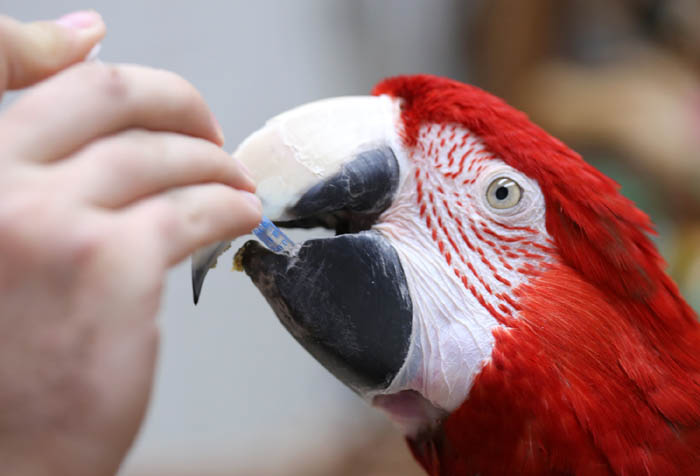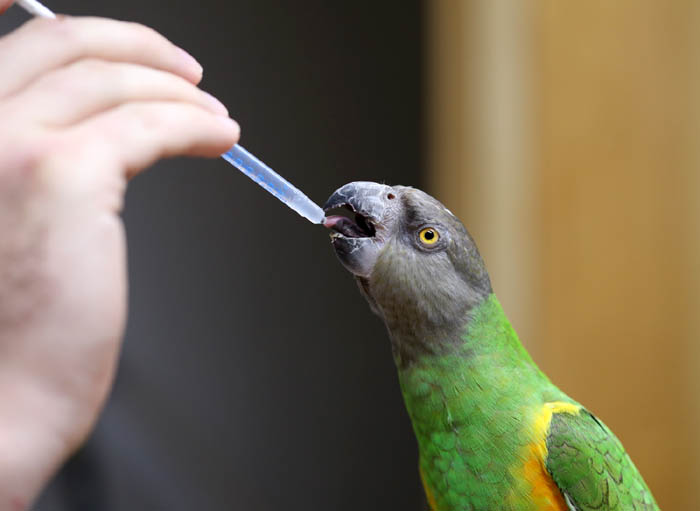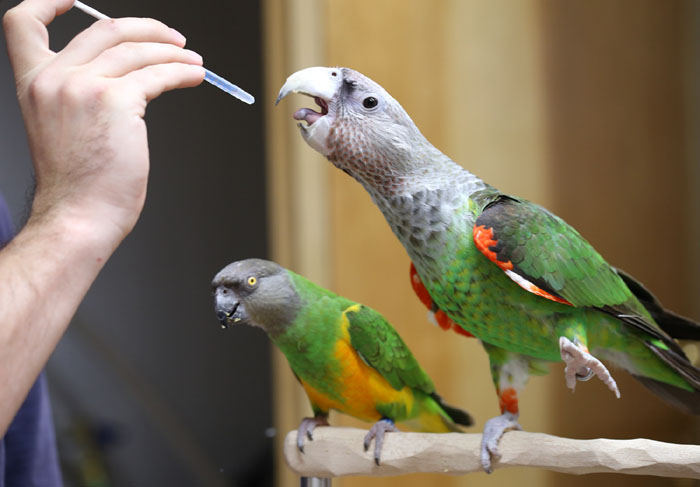This article is about giving medication to multiple parrots in a multi-parrot home. For instructions on giving medication to a single (particularly untrained) parrot, I previously wrote about giving medication to my Green-Winged Macaw.
My flock was diagnosed with Clostridium so now they all have to take medication for 21 days. Santina previously had it and received treatment but it did not stop the other birds from catching it as well. It is not clear if it is the food, environment, or other bird that is the cause. But regardless the entire flock needs to be medicated. The medication is administered orally once a day. The trouble is the duration for which it has to be given. This is a long enough of a period that the parrots must be trained to accept medication. Clever trickery may get you by a few days or a week. But anything longer and the parrot must be on board.
In most cases where a parrot requires medication in a multi-parrot home, the rest of the flock should receive the medication even if they don't show symptoms. My birds all seem to have it because they have been having smelly poop.

So on to the process of medicating a bunch of birds together. This may seem like a lot of work but actually if done right makes things a heck of a lot easier! Using modeling and a healthy dose of competition can get the birds to be more excited about doing something undesirable (like taking medication)!
I medicate the entire flock together and have turned it into a fun game for them. I have been taking advantage of each of my bird's strong points while avoiding their weaknesses in this medication process. This makes it appear to each of the other birds that the one they are watching really loves getting medication.

Kili is a super trained parrot so for her I set taking medication to be like a trick. I taught her to target the syringe, then to sip water, and finally to sip and swallow. Thus when I make the unexpected switch to real medication she just takes it. Santina is a great follower. She likes to do what the others are doing. So between the original medication sessions that I had with her modeling off of me and the recent ones of modeling from the other birds, she is doing very well. Truman is a bit of a runt and doesn't want to take medication but I've been working past that with him as well. He drinks water like a camel so I've been letting him get thirsty and then enjoy drinking a lot of water from the syringe. Because each bird appears eager to participate in the medication process (although each for different reasons) it encourages the remaining birds to cooperate and try harder. Nobody wants the competition to get more!
Here are some more elements that have made the process so successful. I practice the "medication process" with just water in the syringe twice a day although medication only comes once. For every 1 sip of medication, the birds are probably getting 40 sips of water. This makes the undesirable medication not only unpredictable but also fairly negligible in the greater scheme of getting water from the syringe. The birds get pellets as treats so this makes them more thirsty for water sips from the syringe. The pellets also soak up medication in their beaks and ensure that it is swallowed. Also I stopped providing water in the cage and have been giving it by hand only to ensure that the birds desire fluids at the necessary time. Spitting out and not receiving the medicine is far worse. So instead I let them sip some of their drinking water from the syringe and the rest they get from a bowl in my hands. This is similar to when we travel so they are perfectly used to it.

The thirstier/hungrier birds are far less picky. They used to spit out pellets that got medication on them from inside their beaks. Truman in particular would shake his head and spit out the medication. But now with this training system in place, the birds are far more cooperative. With practice, they now know the routine very well and are even more cooperative. In their competition with each other to get water and treats, they seem to forget their resistance to the medication and it is a win/win for everyone.
It is important to understand that the objective is not to simply get the medicine into the bird but to succeed in completing the entire medication process. Tricking or forcing the bird to take medication will only work a few times. In an emergency, you do what you gotta do. But if the bird is in condition to be trained, it is far far better to have a bird that wants to take medication than a bird that flies away or bites you because it knows what is coming. This is why even after the birds get the real medication, I keep practicing with them with the water. In fact, I would say they get the real medication about a quarter of the way into the session. This is when motivation is highest and it makes it least predictable as to when it will happen. Since they all come over to me when they see a syringe, I know I have succeeded in applying positive reinforcement to taking medication!
|




 Older Articles
Older Articles